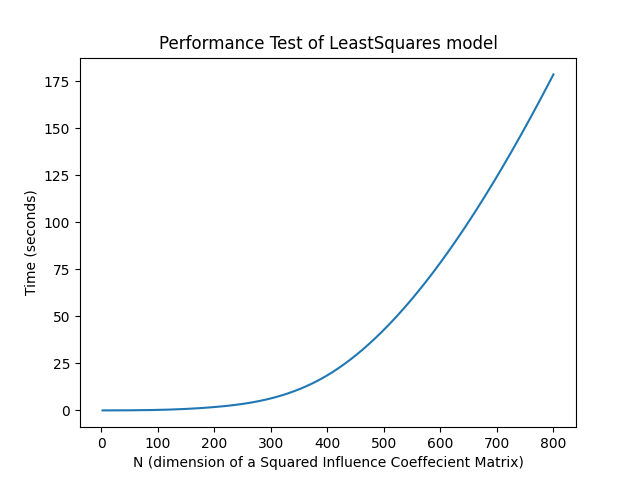Performance Test¶
The package was tested against injected random
Influence coefficient matrices
hsbalance.IC_matrix.Alpha with N x N size. The output
can be summarized in the following plot.
The graph was a test for the Least Squares model. It shows a good time
performance of 800 x 800 matrix under 3 minutes.
The hardware and software for the machine running the test can be
found data/test_conditions.txt
The code below is to generate the previous plot.
import time
from scipy.interpolate import make_interp_spline
import numpy as np
import matplotlib.pyplot as plt
from hsbalance import Alpha, model, tools
def test_performance(n):
'''
Test the performance of model time_wise.
Args:
n : dimension of influence coefficient matrix nxn.
Output:
t : time elapsed in the test rounded to 2 decimal.
'''
# Generate alpha matrix nxn dimension
alpha = Alpha()
real = np.random.uniform(0, 10, [n, n])
imag = np.random.uniform(0, 10, [n, n])
alpha.add(real + imag * 1j)
# Generate initial condition A matrix nx1
real = np.random.uniform(0, 10, [n, 1])
imag = np.random.uniform(0, 10, [n, 1])
A= real + imag * 1j
# start timing
start = time.time()
# building model LeastSquare.
w = model.LeastSquares(A, alpha).solve()
# implement the model to get run time.
error = tools.residual_vibration(alpha.value, w, A)
t = time.time() - start
return round(t, 2)
performance_time = []
N = [2, 10, 50, 100, 200, 400, 600, 800]
for n in N:
performance_time.append(test_performance(n))
print(N, performance_time)
spline = make_interp_spline(N, performance_time)
x = np.linspace(min(N), max(N), 500)
y = spline(x)
plt.plot(x, y, label="Performace Test")
plt.xlabel('N (dimension of a Squared Influence Coeffecient Matrix)')
plt.ylabel('Time (seconds)')
plt.title('Performance Test of LeastSquares model')
plt.show()
